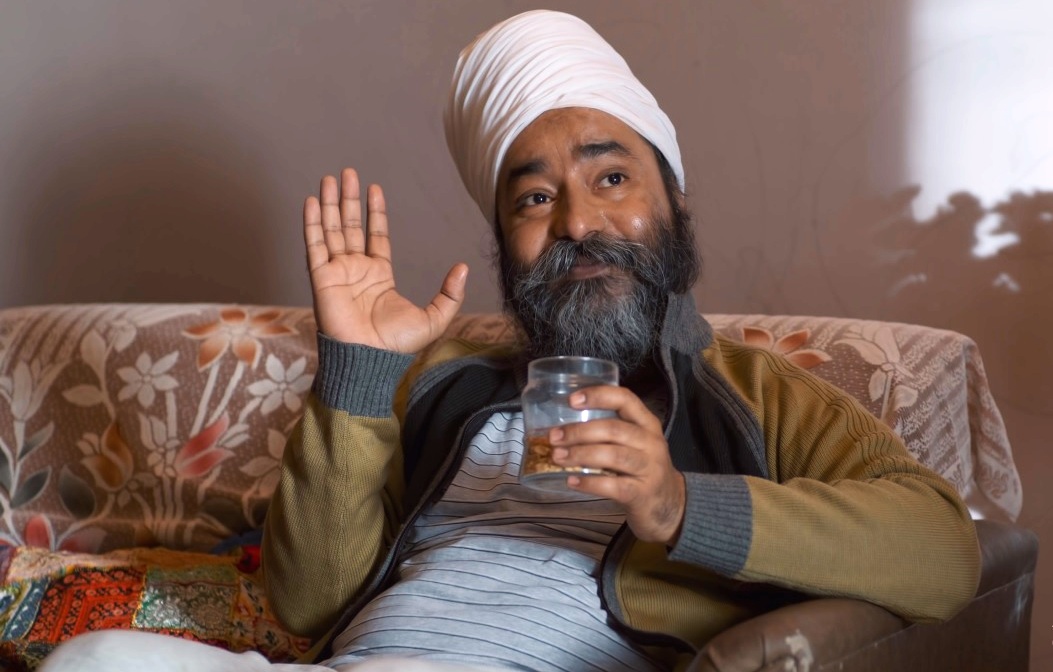Actor-director Kuljeet Singh opens up about the changing landscape of Indian cinema, from the perspective of its depiction of Sikh characters in films
Kuljeet Singh, a Delhi-based theatre actor-director, finds himself at the forefront of a dramatic shift in the depiction of Sikh characters in Indian films and series. Having personally fought the insensitive caricaturing of Sikh characters for over two decades, he is finally claiming the space by essaying a variety of Sikh characters in a realistic space — far from the stereotypical Sikh often shown driving cabs, cracking crass jokes, doing bhangra on random dance numbers, or dying honorably in uniform.
After essaying a very intense Sikh character suffering from germophobia in the Amazon Prime Video series Breathe: Into the Shadows last year, Singh played the part of a resourceful Old Rajinder Nagar-based landlord in the recent TVF series Aspirants, which is about students preparing to crack the UPSC exam. He is also working on two more demanding characters that will further help break the stereotypes associated with Sikh characters. Previously, Singh has also acted in films like Amu and Margarita with a Straw.
In this interview, he talks about his association with Aspirants and the experience of shooting in Old Rajinder Nagar, his continuing battle against stereotypes associated with Sikh characters in films and series, impact of Covid-19 on the functioning of his theatre company Atelier, and his upcoming projects.
Excerpts:
Aspirants seem to have really captured the youth’s imagination. What do you attribute its success to?
I feel the script has played a pivotal role in creating what Aspirant is: pacy, dramatic and impactful. Actors responded exactly to what was needed and Apoorv Singh Karki (the director) knew what he wanted out of it. I think it’s a great cinematic work and I take pride in being a part of the show.
You play the part of a resourceful Old Rajinder Nagar-based landlord in the series. How did you prepare for it? What was the brief given to you by the creative team?
The initial brief was really brief. Subsequently, I asked for the script to know greater details. Unlike many other production houses, I was happy to receive the text instantly to prepare for the performance. On sets, during lunch and tea breaks, Apoorv shared his understanding and I managed to create a backstory to help bring the character of Walia to life. So, basically, it evolved gradually. It started with knowing Walia peripherally before getting closer and closer to it; I believe the discussions significantly helped me.
The setting of Old Rajinder Nagar (the famous hub of UPSC aspirants) gives Aspirants a very realistic touch. What was it like to shoot in Old Rajinder Nagar?
My bank is just close to where we were shooting at Old Rajinder Nagar and I have a great rapport with its manager. It was amusing but I also completed bank work along with the shoot. You know how Dilliwallahs would club things. The narrow-overcrowded lanes and bylanes of Old Rajinder Nagar have so much to offer: anecdotes, characters, chai and poha. While I was doing a retake of a shot and the production was changing lights and creating the frame, this guy on the street asked me, “Uncle Ji, ye shooting ka hero kaun hai? (Who’s the hero of this shoot?).” I looked at him and said, “Main (Me)”, and we shared a smile.
In Breathe: Into the Shadow you played a very intense Sikh character suffering from germophobia. In Aspirants you yet again play a very realistic Sikh character, but this time around it’s in a light-hearted space. How different was the experience this time?
Well, both Prithpal Singh Bharaj of Breathe: Into The Shadows & Walia of Aspirants are distant from me as characters. I had a lot to think, explore and do. Prithpal was a detailed character and required more psychological understanding whereas Walia demanded emotional and physical curve. Maza aaya dono mein hi (Had fun while playing both these parts). I am glad filmmakers have begun to visualize Sikh actors in realistic space and time, finally.
The filmmakers are certainly becoming more conscious, but over the years we haven’t had many Sikh characters that don’t end up as caricatures. How do you see this shift?
I am glad things are changing. It was required not only for actors like me but for the cinema makers and goers. Sikhs, like many other communities are a part of our social reality and caricaturing them on celluloid would reflect a demeaning and narrow point of view on the film community. I am often reminded about my beginning in late ‘90s as a student when I was so conscious and under-confident of myself, to the 2020s — when I am claiming the space as an actor and this took me two decades. I am presently working on two more demanding characters and I hope this change will only grow from here.
You run a theater group called Atelier in Delhi. Tell us about its activities. How has its functioning been impacted by Covid-19?
In 2019, Atelier took a big leap by shifting to Ghitorni, a suburb in Delhi. We created a performance cafe, repertory rehearsal space and black box. We fought the first wave of Covid-19 bravely but succumbed to the second wave on various grounds. Unwillingly, we have had to vacate the space. Presently, Atelier is working from Greater Noida. Most of our work is online and I hope things would improve soon, and Team Atelier would start meeting in person.
In the last 15 months we managed only five online shows and three theatre programmes, which is 10 percent of our annual work in normal times. We have lost work, funds and opportunities. But we haven’t lost hope. Currently, we are looking for new avenues.
Who have been your influences and inspirations over the years? Also, tell us about your upcoming projects.
Habib Tanvir Sahab’s work has inspired me a lot. I have read and watched most of his works and also got an opportunity to sit through his rehearsals during my college days. My college and university professors, especially Dr. BS Rattan and Prof. TS Satyanath, filled me with a lot of enthusiasm while teaching literature, theatre and life, and I will always be indebted to them.
With Atelier Repertory Company, I plan to do two new theatre productions: Eidgaah Ke Jinnat by Abhishek Majumdar and a self-written play titled Chootiyey. Besides, there is a daastaan that I have scripted titled Daastaan-e-Tegh Bahadur to celebrate the spirit of Guru Tegh Bahadur, which is awaiting premier due to Covid-19.
Also, there are two screenplays that I am presently working on for the OTT space: one on Manto called 292 and another called Heer Shakespeer. Both are in the pipeline.
My countryside studio at Greater Noida would also see theatre shows and training programmes once the situation improves.
(Cover: Kuljeet Singh as landlord Walia in Aspirants)





